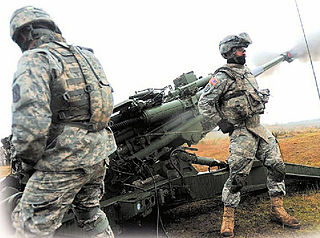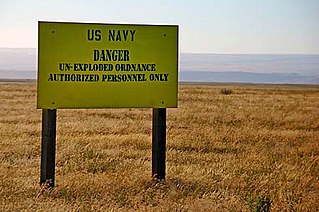
Fort Lewis is a United States Army base located 9.1 miles (14.6 km) south-southwest of Tacoma, Washington. Fort Lewis was merged with McChord Air Force Base on February 1, 2010, to form Joint Base Lewis–McChord.

The United States Forces Japan (USFJ) is a subordinate unified command of the United States Indo-Pacific Command. It was activated at Fuchū Air Station in Tokyo, Japan, on 1 July 1957 to replace the Far East Command. USFJ is headquartered at Yokota Air Base in Tokyo and is commanded by the Commander, US Forces Japan who is also commander of the Fifth Air Force.

Fort Devens is a United States Army Reserve military installation in the towns of Ayer and Shirley, in Middlesex County and Harvard in Worcester County in the U.S. state of Massachusetts. Due to extensive environmental contamination it was listed as a superfund site in 1989. Most of the fort's land was sold off in 1996, but the cantonment area of the post was retained by the Army as the Devens Reserve Forces Training Area (RFTA). Fort Devens was reactivated in May 2007, though no units of active Army have been located there. The Devens Range Complex operates on property in Lancaster, south of Route 2, for live-fire training with small arms, machine guns, grenades, and rockets.

The Smithsonian Conservation Biology Institute (SCBI) is a unit of the Smithsonian Institution located on a 3,200-acre (13 km2) campus located just outside the town of Front Royal, Virginia. An extension of the National Zoo in Washington, D.C., the SCBI has played a leading role in the fields of veterinary medicine, reproductive physiology and conservation biology since its founding in 1974.

Tobyhanna Army Depot (TYAD) is a 'full-service electronics maintenance facility' tasked to provide logistical support for Command, Control, Communications, Computers, Cyber, Intelligence, Surveillance, and Reconnaissance (C5ISR) Systems for the United States Department of Defense. The depot was established on February 1, 1953, in Coolbaugh Township, Monroe County, near Tobyhanna, Pennsylvania.

The Oregon Army National Guard is a federally mandated and equipped military organization under the civilian direction of the Oregon Military Department, with the Governor of Oregon as its Commander-in-Chief. It responds to state and national emergencies, military conflicts and natural disasters, and conducts search and rescue operations. While the history of the militia dates back to the establishment of the first Oregon militia in 1843, the present Guard was not established until after 1903. The modern Guard includes citizen soldiers, and its motto is "When we are needed, we are there."

Camp Blanding Joint Training Center is the primary military reservation and training base for the Florida National Guard, both the Florida Army National Guard and certain nonflying activities of the Florida Air National Guard. The installation is located in Clay County, Florida, near the city of Starke in adjacent Bradford County. However, while Camp Blanding utilizes a Starke address, it is located totally within the confines of Clay County. The site measures about 73,000 acres (30,000 ha) and includes Kingsley Lake. It also hosts other Reserve, Army National Guard, Air National Guard, and some Active Component training for the U.S. Armed Forces.

James Withycombe was an English-born American Republican politician who served as the 15th Governor of Oregon.
Fort Holabird was a United States Army post in the city of Baltimore, Maryland, active from 1918 to 1973.

The Oregon Military Department is an agency of the government of the U.S. state of Oregon, which oversees the armed forces of the state of Oregon. Under the authority and direction of the governor as commander-in-chief, the agency is responsible for planning, establishing, and enforcing rules and procedures governing the administration, supply, and training of the Oregon National Guard, when not in the active service of the United States. The Department also maintains all state-owned or leased military facilities, including posts, camps, military reservations, and rifle ranges.

Camp Bullis Military Training Reservation is a U.S. Army training camp comprising 27,990 acres (113.3 km2) in Bexar County, Texas, USA, just northwest of San Antonio. Camp Bullis provides base operations support and training support to Joint Base San Antonio. The camp is named for Brigadier General John L. Bullis.

Camp Wellfleet is a former United States military training camp. It occupies about 1,738 acres (7.03 km2) of land located along the Atlantic Ocean in the town of Wellfleet, Massachusetts on Cape Cod. The 548th Antiaircraft Artillery Battalion used the Camp for a firing range from 1954-1956. The majority of the site is owned and maintained by the National Park Service, as the administrator of the Cape Cod National Seashore. The Town of Wellfleet owns a portion of the site. It was officially opened on March 19, 1943.
Camp Calvin B. Matthews or Marine Corps Rifle Range Camp Matthews or Marine Corps Rifle Range, La Jolla or more simply Camp Matthews was a United States Marine Corps military base from 1917 until 1964, when the base was decommissioned and transferred to the University of California to be part of the new University of California, San Diego campus. Over a million Marine recruits as well as other shooters received their marksmanship training at this military base.

Camp Gruber is an Oklahoma Army National Guard (OKARNG) training facility. It covers a total of 87 square miles (230 km2).
Camp Santiago Joint Training Center is a military training installation controlled by the Puerto Rico National Guard on 6,500 hectares of land located in Salinas, Puerto Rico. This training facility was named posthumously after Medal of Honor recipient and native of Salinas, Puerto Rico, Specialist Four Héctor Santiago-Colón.

The Oregon Military Museum (OMM) at Camp Withycombe in Clackamas County, Oregon, honors, shares, and preserves Oregon’s military heritage and legacy, including the Oregon National Guard, the state’s early militias, and all branches of the US Armed Forces. Slated to open in 2023, the Museum’s main building includes the main drill floor, weapons, and temporary galleries for permanent and rotating exhibits, as well as the Conference Classroom, Museum Store, Hall of Valor, and the Thomas E. Withycombe Library. Surrounding the main building, the Historic Park, open seasonally, includes two historic buildings, the Quartermaster Storehouse and the Battery A Field Artillery Horse Barn, as well as an outdoor tracked vehicles (tanks) display. The Museum also maintains a Restoration Shop on post.
Cheli Air Force Station, formerly located within Bell in southeastern Los Angeles County, California, was a United States Air Force installation and a Cold War Radar Bomb Scoring site of the Strategic Air Command, from 1947 to 1961.

The Naval Weapons Systems Training Facility Boardman, informally known as the Boardman Bombing Range, is a military installation south of Boardman, Oregon in the United States. It is used by NAS Whidbey Island as their principal training grounds for testing EA-18G Growler aircraft and for drone testing. It is located about 70 miles (110 km) south of the Yakima Training Center, which is used by Joint Base Lewis-McChord for training exercises and about 15 miles (24 km) west of the now closed Umatilla Chemical Depot.















